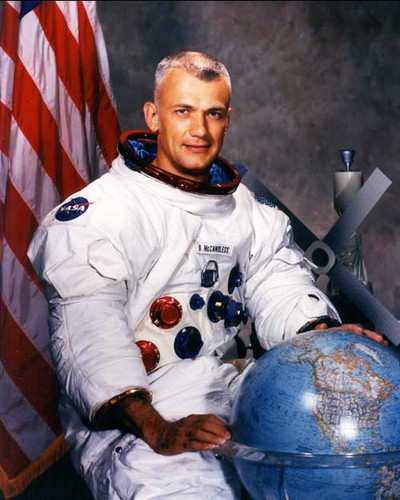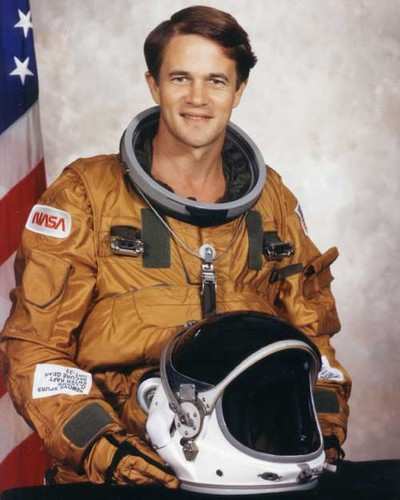Fourth Class of Space Shuttle Astronauts to be Inducted into
Hall of Fame
The world's first untethered spacewalker, an astronaut who
snared two crippled satellites on the first space salvage mission,
and a Space Shuttle Commander who overcame an engine failure to
reach orbit have been chosen for 2005 induction into the US
Astronaut Hall of Fame.

Bruce McCandless )above and below), Joe Allen and Gordon
Fullerton will join such Astronaut Hall of Fame American heroes as
Neil Armstrong, John Glenn, Alan Shepard, Jim Lovell and Sally Ride
when they are enshrined during an April 30, 2005 public ceremony at
Kennedy Space Center Visitor Complex.

The inductees were selected by a committee of current Hall of
Fame astronauts, former NASA officials and flight directors,
historians, journalists and other space authorities in a process
administered by the Astronaut Scholarship Foundation.
The stiff, toy-like figure appeared to hang suspended in space,
silhouetted against a deep black sky, with a bright blue,
cloud-mottled earth curving below. This was a man, a human
satellite, the first person to fly free in space, without a
lifeline attached to the mother ship. Bruce McCandless was 320 feet
away from the shuttle Challenger, controlling himself perfectly by
triggering small jets that spit bursts of nitrogen gas from a pack
on his back. Three more successful tests of the pack, one by
McCandless, two by Robert Stewart, helped erase some of the gloom
the astronauts felt after the failure of two communications
satellites -- Westar VI and Palapa B2 -- that were deployed soon
after Challenger lifted off in February 1984. Rocket motors
designed to lift the payloads to higher orbits did not fire
properly and left them in the wrong orbits. McCandless returned to
space aboard Discovery in April 1990 with a five-person crew that
released the Hubble Space Telescope, which opened a striking new
window of the universe for astronomers.

Joe Allen (above) put the back pack pioneered by McCandless to
practical use in November 1984 when Discovery roared into space on
the first space salvage mission - to recover Westar VI and Palapa
B2. Commander Rick Hauck steered the shuttle close to Palapa, and
Allen and Dale Gardner, wearing space suits, slipped outside and
Allen moved untethered over to the satellite. He latched onto it
and moved it into position above the cargo bay. For 90 minutes,
Allen held aloft the 1,200-pound payload - like Atlas holding the
world on his shoulder - while Gardner worked on it before they
lowered it manually into the cargo bay. Allen and Gardner used the
same procedures two days later to secure Westar. Back on earth,
both satellites were refurbished for return to orbit. On an earlier
flight, Allen was part of a four-man crew that rode Columbia into
space in November 1982 on the shuttle's first operational mission,
delivering satellites to orbit for paying customers. After
successfully deploying communications packages for Satellite
Business Systems and Telesat Canada, the crew displayed a sign:
"Ace Moving Co. We Deliver!"

Shuttle Challenger was 5 minutes 45 seconds off the launch pad
on July 29, 1985, when one of its three main engines suddenly shut
down. "We show a center engine failure," commander Gordon Fullerton
radioed. Mission Control determined that by burning the two
remaining engines 86 seconds beyond the planned 8 minutes 31
seconds, Challenger could reach orbit. "Abort to orbit,"
controllers radioed. Fullerton (above) skillfully supervised the
burning of the two working engines the extra time and settled into
orbit. The trauma behind them, the crew of seven, including five
scientists, settled in for a week of scientific experiments.
Earlier, Fullerton and commander Jack Lousma were at the controls
when Columbia took off March 22, 1982 on its third test flight
during which they thoroughly wrung out all its systems.
As Columbia neared the end of the week-long trip, rains turned
into a quagmire over the hard-packed desert sands at Edwards Air
Force Base, CA. NASA did not feel the shuttle mature enough yet to
land on the narrow runway at the Kennedy Space Center and instead
directed the astronauts to an emergency backup site, the desolate
Northrup Strip in the edge of New Mexico's White Sands Missile
Range.
This is the fourth group of Space Shuttle astronauts named. Once
inducted, they will increase the number of space explorers
enshrined in the Hall of Fame to 60. Earlier inductees came from
the Mercury, Gemini, Apollo, Skylab and Apollo-Soyuz programs.
To be eligible for induction, an astronaut must have made his or
her first flight at least 20 years before the induction year and
must be retired from NASA's astronaut corps at least five years. A
candidate must be a US citizen, NASA-trained and must have orbited
the earth at least once. In balloting, committee members evaluate
not only an individual's flight accomplishments but also how he or
she contributed to the success and future success of the US space
program in post-flight assignments.
 ANN's Daily Aero-Linx (04.13.24)
ANN's Daily Aero-Linx (04.13.24) ANN's Daily Aero-Term (04.13.24): Beyond Visual Line Of Sight (BVLOS)
ANN's Daily Aero-Term (04.13.24): Beyond Visual Line Of Sight (BVLOS) Airborne 04.09.24: SnF24!, Piper-DeltaHawk!, Fisher Update, Junkers
Airborne 04.09.24: SnF24!, Piper-DeltaHawk!, Fisher Update, Junkers Aero-News: Quote of the Day (04.14.24)
Aero-News: Quote of the Day (04.14.24) ANN's Daily Aero-Term (04.14.24): Maximum Authorized Altitude
ANN's Daily Aero-Term (04.14.24): Maximum Authorized Altitude






